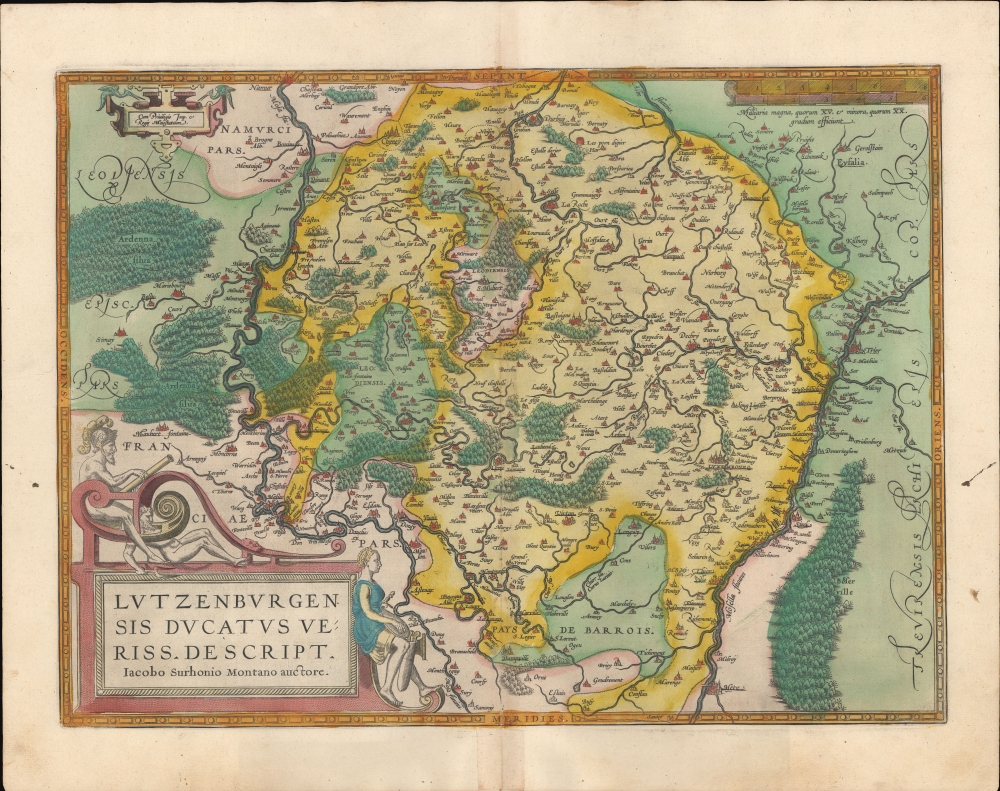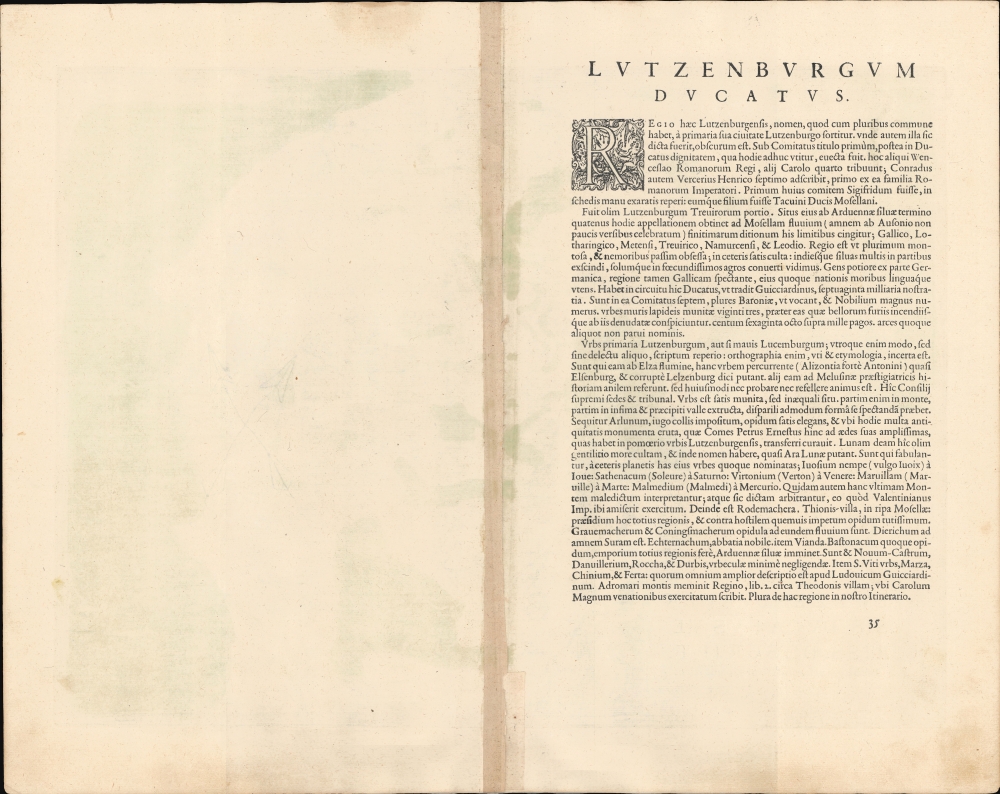This item has been sold, but you can get on the Waitlist to be notified if another example becomes available, or purchase a digital scan.
1595 Ortelius Map of Luxembourg
Luxembourg-ortelius-1595
Title
1595 (undated) 14 x 20 in (35.56 x 50.8 cm) 1 : 400000
Description
Sources
This map is based on a 1551 map of Luxembourg made by Jean de Surhon for Holy Roman Emperor Charles V (1500 - 1558) in 1551. Seen as a threat to state security, the Surhon map was never published - at least, not until 1579, when Antwerp was briefly independent. At that time, Ortelius used Surhon as a source, producing this map. Other sources include geographic data by Tilemanus Stella Sigensis (not previously published), by Christian Schrot, and Ioannes Scillius (not previously published).Historical Context
In the late 1500s, Luxembourg was tumultuously caught between the great powers of Europe. It was a period dominated by the Habsburgs, under whose rule the territory was a part of the Spanish Netherlands. The Protestant Reformation, which was sweeping through Europe, also touched Luxembourg, leading to religious tensions and conflicts. Strategically positioned, Luxembourg was a coveted prize and often became a battleground between the rivaling powers, particularly during the Eighty Years’ War (1568 - 1648) between Spain and the Dutch Republic. Despite these challenges, its fortified city, with impressive walls and bastions, stood as a testament to Luxembourg's resilience and strategic importance.Publication History and Census
This map was engraved and first added to the Ortelius Atlas in 1570. It is the fourth state, corresponding to Ort 60.4, retooled with additional hachuring in the cartouche. The present example conforms typographically to the 1595 Latin edition of the work (1595L35). This map is well represented in institutional collections and appears on the market from time to time.CartographerS
Abraham Ortelius (April 14, 1527 - June 28, 1598) also known as Ortels, was a cartographer, geographer, and cosmographer of Brabant, active in Antwerp. He was the creator of the first modern atlas, Theatrum Orbis Terrarum and is a seminal figure in the history of cartography. Along with Gerard Mercator and Gemma Frisius, he was a founder of the Netherlandish school of cartography. His connections with Spain - culminating in his 1575 appointment as Royal Cartographer to King Phillip II of Spain - gave him unmatched access to Spanish geographical knowledge during a crucial period of the Age of Discovery. Ortelius was born in 1527 in Antwerp. In 1547 he entered the Antwerp Guild of Saint Luke as an illuminator of maps. He began trading in books, prints, and maps, traveling regularly to the Frankfurt book and print fair, where in 1554 he met Mercator. He accompanied Mercator on journeys throughout France in 1560 and it was at this time, under Mercator's influence, that he appears to have chosen his career as a scientific geographer. His first published geographic work appeared in 1564, an eight-sheet cordiform world map. A handful of other maps preceded the 1570 publication of the first edition of the Theatrum Orbis Terrarum, which would prove to be his life work. Appearing with but 53 maps in its first edition, Ortelius' work expanded with new maps added regularly. By 1592, it had 134 maps. Many of Ortelius' maps remained the standard for nearly a century. He traveled extensively, but his genius was as a compiler, locating the best informed maps on which to base his own. His contacts throughout Europe and extending even (via the Portuguese) to the Far East were formidable. Moreover, many of his maps were based on his own scholarship, particularly his historical works. His theories of geography were particularly ahead of his time with respect to the notion of continental drift, the possibility of which he mused on as early as 1596, and which would be proven correct centuries later.
In a sense his greatest achievement was his successful navigation of the religious and political violence endemic to his city throughout his adult life: The Dutch Revolt, or Eighty Years' War (1568 - 1648), fully embroiled Antwerp. Although outwardly and officially recognized as Catholic (Arias Montanus vouched for Ortelius' Catholic orthodoxy prior to his appointment as Royal Geographer), Ortelius was able to separate himself from the religious furor which characterized the war in the low countries. Ortelius showed a glimpse of himself in a letter to a friend, regarding humanist Justus Lipsius: 'I do not know whether he is an adherent of the Pope or a Calvinist, but if he has ears to hear, he will neither be one nor the other, for sins are committed on both sides'. Ortelius' own explorations of Biblical history in his maps, and the Christogram contained in his own motto, suggest him to be a religious man, but his abjuration of political religious authorities mark him as an individualist. His tombstone at St Michael's Præmonstratensian Abbey in Antwerp bears the inscription, Quietis cultor sine lite, uxore, prole. ('served quietly, without accusation, wife, and offspring.') More by this mapmaker...
Jean de Surhon (fl. 1550 - 1600) was a Franco-Flemish engraver and cartographer. His father and brother, both named Jacques, were engravers and cartographers as well: his father was also a silversmith. He is remembered for those of his maps which were incorporated in Ortelius' Theatrum Orbis Terrarum: those of Namur (1553), Vermandois (1557), Luxembourg (1551), and Picardy (1557). The original maps do not appear to have survived, and thus Ortelius' versions are the earliest acquirable to the collector. The first, 1570 edition of the Theatrum contained the map of Vermandois: Namur and Picardy first appeared in the 1579 edition. It is a testament to Surhon's maps that no improvement was made to them until the second half of the seventeenth century: Willem Blaeu's atlas would reprise Surhon's work in a faithful, though more beautiful copy of the Ortelius. Learn More...




